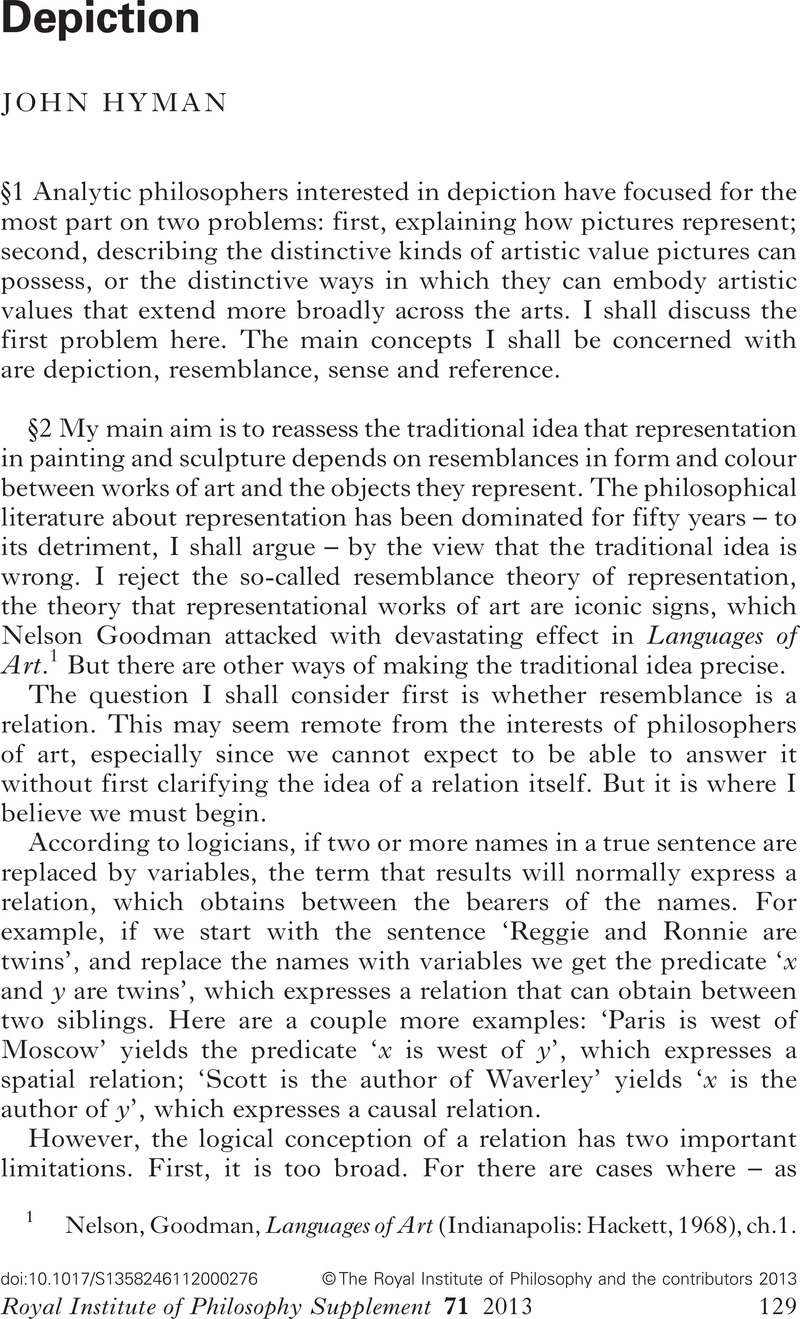Published online by Cambridge University Press: 11 March 2013

1 Nelson, Goodman, Languages of Art (Indianapolis: Hackett, 1968), ch.1Google Scholar.
2 Kenny, A.J.P., Action, Emotion and Will (London: Routledge & Kegan Paul, 1963), ch.7Google Scholar.
3 Prior, A.N., The Doctrine of Propositions and Terms (London: Duckworth, 1976), 29Google Scholar.
4 Locke, Essay Concerning Human Understanding, 2.25.5.
5 Oxford English Dictionary, relation, 2.a.
6 The phrase ‘namely-rider’ was coined by Ryle. See Ryle, G., ‘Heterologicality’ repr. in Collected Papers II (London: Unwin Hyman, 1971), 250–57Google Scholar.
7 Hopkins, R., Picture, Image and Experience (Cambridge: CUP, 1998), 10fGoogle Scholar.
8 Routledge Encyclopedia of Philosophy, Depiction, §1.
9 Abell, C., ‘Canny Resemblance’, Philosophical Review 118 (2009), 186CrossRefGoogle Scholar.
10 On this topic, see Rundle, Bede, Grammar in Philosophy (Oxford: OUP, 1979)Google Scholar; Sainsbury, Mark, Reference without Referents (Oxford: OUP, 2005), chs 2 & 6Google Scholar.
11 ‘On Sense and Reference’ in Translations from the Philosophical Writings of Gottlob Frege, ed. and trans. Geach, P. & Black, M., third edition (Oxford: Blackwell, 1980).Google Scholar
12 Wollheim, R., Painting as an Art (London: Thames and Hudson, 1988), 46Google Scholar.
13 See Budd, M., ‘On Looking at a Picture’, in Hopkins, Jim & Savile, Anthony (eds), Psychoanalysis, Mind and Art (Oxford: OUP, 1992)Google Scholar; Hyman, J., The Objective Eye (Chicago, Ill.: Univ. of Chicago Press, 2006), ch.7Google Scholar.
14 Wittgenstein, L., The Blue and Brown Books, second edition (Oxford: Basil Blackwell, 1969), 32Google Scholar.
15 Goodman, op. cit., 5.
16 Kulvicki, John, ‘Pictorial Diversity’ in Abell, Catharine & Bantinaki, Katerina, eds., Philosophical Perspectives on Depiction (Oxford: OUP, 2010)Google Scholar.
17 Descartes, R., Philosophical Writings I, trans. Cottingham, J. et al. (Cambridge: CUP, 1985), 165Google Scholar.
18 Podro, M., ‘Literalism and Truthfulness in Painting’, British Journal of Aesthetics 50 (2010)CrossRefGoogle Scholar.
19 Ibid., 457f.
20 There is a good discussion of the use of single and multiple vanishing-points as organizing principles in fifteenth-century painting in White, J., The Birth and Rebirth of Pictorial Space second edition (London: Faber & Faber, 1967), 196ffGoogle Scholar.
21 Riegl, A., The Group Portraiture of Holland, trans. Kain, E.M. (Los Angeles: Getty Research Institute, 1999), 285Google Scholar.
22 On this topic, see The Objective Eye, ch.10.